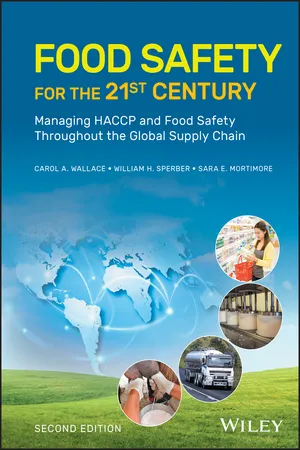
Food Safety for the 21st Century
Managing HACCP and Food Safety Throughout the Global Supply Chain
- English
- ePUB (mobile friendly)
- Available on iOS & Android
Food Safety for the 21st Century
Managing HACCP and Food Safety Throughout the Global Supply Chain
About this book
Revised to reflect the most recent developments in food safety, the second edition of Food Safety for the 21st Century offers practitioners an authoritative text that contains the essentials of food safety management in the global supply chain. The authors — noted experts in the field — reveal how to design, implement and maintain a stellar food safety programme. The book contains industry best-practices that can help businesses to improve their systems and accelerate the application of world-class food safety systems. The authors outline the key food safety considerations for individuals, businesses and organisations involved in today's complex global food supply chains.
The text contains the information needed to recognise food safety hazards, design safe products and processes and identify and manage effectively the necessary control mechanisms within the food business. The authors also include a detailed discussion of current issues and key challenges in the global food supply chain. This important guide:
• Offers a thorough review of the various aspects of food safety and considers how to put in place an excellent food safety system
• Contains the information on HACCP appropriate for all practitioners in the world-wide food supply chain
• Assists new and existing business to meet their food safety goals and responsibilities
• Includes illustrative examples of current thinking and challenges to food safety management and recommendations for making improvements to systems and practices
Written for food safety managers, researchers and regulators worldwide, this revised guide offers a comprehensive text and an excellent reference for developing, implementing and maintaining world-class food safety programmes and shows how to protect and defend the food supply chain from threats.
Frequently asked questions
- Essential is ideal for learners and professionals who enjoy exploring a wide range of subjects. Access the Essential Library with 800,000+ trusted titles and best-sellers across business, personal growth, and the humanities. Includes unlimited reading time and Standard Read Aloud voice.
- Complete: Perfect for advanced learners and researchers needing full, unrestricted access. Unlock 1.4M+ books across hundreds of subjects, including academic and specialized titles. The Complete Plan also includes advanced features like Premium Read Aloud and Research Assistant.
Please note we cannot support devices running on iOS 13 and Android 7 or earlier. Learn more about using the app.
Information
Part I
Food Safety Challenges in the 21st Century
1
Origin and Evolution of the Modern System of Food Safety Management: HACCP and Prerequisite Programmes
1.1 Historical Perspectives
Table of contents
- Cover
- Table of Contents
- Dedication
- About the Authors
- Foreword
- Acknowledgements
- Glossary of Terms and Acronyms
- How to Use This Book
- Part I: Food Safety Challenges in the 21st Century
- Part II: Foodborne Hazards and Their Control
- Part III: Systematic Food Safety Management in Practice
- Part IV: Food Safety Management in Practice: Current Issues and Challenges in Areas of the Global Food Supply Chain
- Epilogue
- References
- Appendix 1: Manufacturing HACCP Case Study
- Appendix 2: Global Food Safety Resources *
- Index
- End User License Agreement